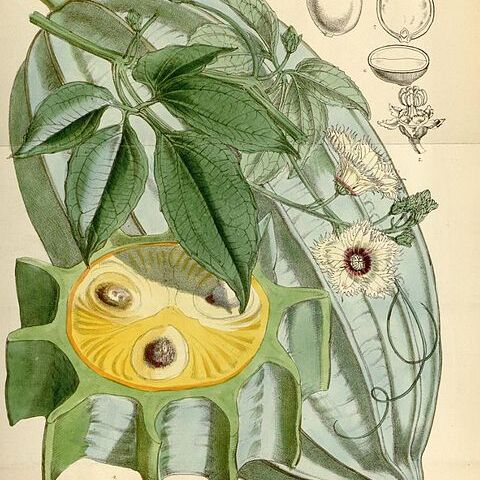Liane.. Stems herbaceous, ribbed, glabrous or pubescent, climbing to 15 m. or more, perennial, becoming thickened when old.. Leaves petiolate, 3–5-foliolate; median leaflet elliptic, acuminate, acute, tapered into the petiolule, entire or shallowly sinuate-toothed, glabrous or sparsely hairy or punctate, 3-nerved from near the base with 2 well-developed ascending lateral nerves, 60–170 mm. long, 30–100 mm. broad; lateral leaflets similar; petiolules 2–20 mm. long; petiole 19–80 mm. long, pubescent like the petiolules.. Probracts 5–8 mm. long.. Male flowers in 100–300 mm. long racemes; bracts 2.5–8 mm. long, 1.5–3 mm. broad; pedicels 8–35 mm. long; receptacle-tube campanulate, 2.5–3.5 mm. long, densely glandular-hairy inside above; lobes triangular, glandular-dentate, 2–4 mm. long; petals ± 25 × 12 mm., white with dark purple mark at the base inside; stamens 3; anthers coherent in centre of flower.. Female flowers stalked, details unknown.. Fruit whitish when ripe, with yellowish flesh, ellipsoid, tapered at both ends, rather sharply 10-ribbed, up to ± 600 mm. long.. Seeds many, very broadly and asymmetrically ovate in outline, 32–36 × 33–37 × 10–12 mm.; testa smooth, with the endocarpic fibrous sheath poorly developed or absent.. Fig. 1/7, p. 14.
More
A pumpkin family plant. It is a strong vine which loses its leaves during the year. Stems can be 10 m long. The leaves have 3-5 leaflets which look like claws. They are arranged like fingers on a hand. The stalk of the leaflets is about 2.5 cm long. The leaflets have teeth on the edge of the top part of them. They are often rough underneath. The vine has tendrils which are branched and with coiled tips which clasp objects. Plants are separately male and female. Male plants have tougher shoots and smaller leaves. The male flowers are on flower stalks 5-25 cm long. Female flowers occur singly and are on short stalks. Female flowers are in the axils of leaves. Male flowers are small, pink and in clusters. The fruit are pale green and covered with a white waxy layer that rubs off easily. Fruit are strongly ribbed at maturity. They can be 25 cm long and weigh 3-6 kg. The flesh is light yellow and fibrous. The seeds are flattened, round and 3.5 cm across. There are 30-70 seeds in each fruit.
Fruit pale glaucous green, about 2 ft. long and 10 in. diam. with broad ridges
A perennial climber, attaining 100 ft. in length
Corolla creamy-white with a red-purple eye
The thick shoots of the female plant are chopped and used on soups. The seeds are stripped of their coat then ground and used in soups. The seeds are also boiled in their seed coats then shelled and eaten. The seeds yield a cooking oil. The young shoots and leaves are used as a potherb. They are also added to soups and stews. They can also be dried and stored. CAUTION: The roots are poisonous.
Plants are grown from seed. Seed can be sown directly or put in a nursery then transplanted. Seedlings appear within 12-15 days. The vines need a trellis to climb over. Male plants flower in 3 months while female plants take 4-5 months to flower. Seed can be stored for 3-4 months if kept dry and cool but the seeds must not be dried.

